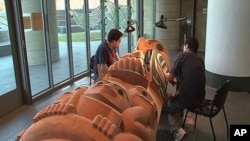In the mid to late 18th century, missionary schools were opened on Native American reservations in the U.S. The goal was to convert young people to Christianity and immerse them in Western culture. Native languages and culture were discouraged. Over decades, many grew up knowing little about their culture or languages. One Tsimshian tribesman has dedicated his life to keeping his native culture alive.
David Boxley is a Native American artist from the Tsimshian tribe in Alaska. He's a dancer, songwriter, and wood carver. More importantly, he's an ambassador for Tsimshian culture and heritage.
“We call it art now, but it was a way for people to say, 'This is who I am. This belongs to me.' Or 'This is my clan, this is my crest, this is my family history, carved and painted in wood.'”
Boxley was raised by his grandparents. He said Christian missionary influence was strong while he was growing up. So he learned little about his native culture.
While working as a teacher after college, he began researching Tsimshian wood carving in ethnographic materials and museum collections. In 1986, he left teaching to devote his time to wood carving and reviving Tsimshian art and culture.
“I guess I came along at the right time. Our people really needed a shot in the arm. Our culture wasn’t very prominent after all that missionary influence, and years and years of not having anybody be in that kind of position to guide,” said Boxley.
Almost 30 years later, he's putting the finishing touches on his 70th totem pole, which will stand in the permanent collection at the National Museum of the American Indian in Washington, D.C.
“We don’t use sandpaper. We use the knives and the chisels to get it as smooth as possible. Get the lines clean,” said Boxley.
Totem poles tell a story. This one is carved from a seven-meter-long piece of red cedar. Boxley began carving it several months ago at his home near Seattle in Washington state. It was shipped across country by truck.
“The title is Eagle and the Young Chief,” said Boxley.
The pole tells the story of a young chief who rescued an eagle snared in a fishing net. Years later, when the Chief’s village was starving, the eagle repaid the chief for his kindness.
“A live salmon fell out of the sky, and he looked up and he saw the eagle flying away. And every day for days and days, the eagle brought salmon to feed the village,” said Boxley.
Boxley said the pole he carved in honor of his grandfather is closest to his heart. This one is a close second.
“This one is going to be seen by millions over the next hundred years. And it is not just me and my son; it is all of my people that are proud … my tribe,” said Boxley.
On the day the pole was unveiled, Boxley’s dance troupe of family and friends performed for a large audience.
Then, the unveiling.
Boxley has other wood carvings in the permanent collection of the museum. This one ensures Tsimshian culture will have pride of place in native American history.














